French Macarons
This post may contain affiliate links. Read the full disclosure here.
Follow these carefully explained instructions with photographs included in this French Macarons recipe. This tutorial will break down exactly what you need to do in order to achieve success each and every time you make macarons.
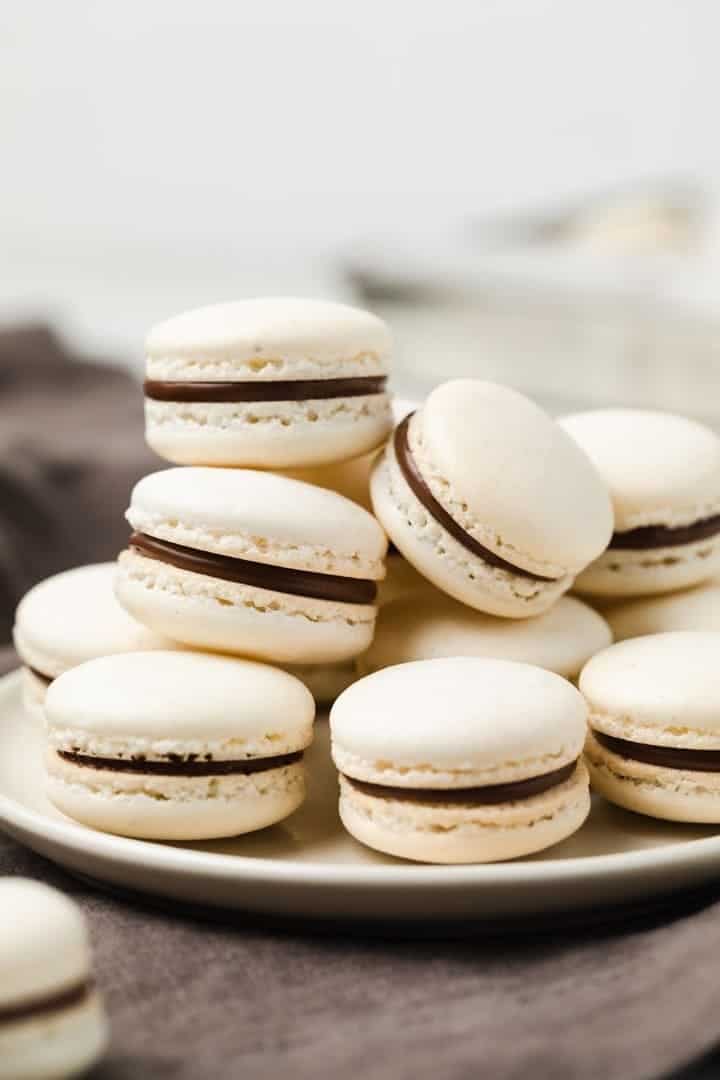
If you’ve ever had a macaron you know all too well how incredible these delicate cookies are.
They are made by whisking egg whites until a stiff-peaked meringue forms. Then sifted, almond flour and powdered sugar are folded in slowly until the desired consistency is reached. This process of knocking out air and folding is called macaronage.
The end result is a delicate meringue-based cookie that’s crisp on the outside and slightly moist and chewy on the inside. When the shells meld with the filling, it creates a delectable texture contrast. So, so good!
According to Wikipedia, the macaron is thought to have been introduced in France by the Italian chef of queen Catherine De Medici during the Renaissance.
French macarons are finicky and require accurate measurements and a proper technique to make. It’s extremely important to weigh each ingredient. And it’s even more important to complete each step with the proper technique.
It takes practice! It took me several months of continuous practice to learn the basics and perfect the technique. So don’t be discouraged if your macarons do not turn out the first time. Keep at it!
Don’t attempt making macarons on a humid day!! This was my problem when I first began experimenting. It was too humid where I live in the summer. Winter offers less humidity. Plus the air inside is drier due to running the heat.
Now that I’ve mastered the technique I can easily whip up a batch of easter macarons, strawberry macarons or salted caramel ginger macarons anytime the mood strikes.
Why this recipe works:
I’ve tried a variety of ratios and techniques for macarons and have found the very best way to make them.
- Only gram measurements are given! This is because using the exact amount of each ingredient is crucial to the success of your macarons.
- Whipping the egg whites to the proper consistency is also very important. Pay attention and read the instructions fully.
- Understanding how the final batter should look and feel will help you immensely when it comes to getting the recipe right.
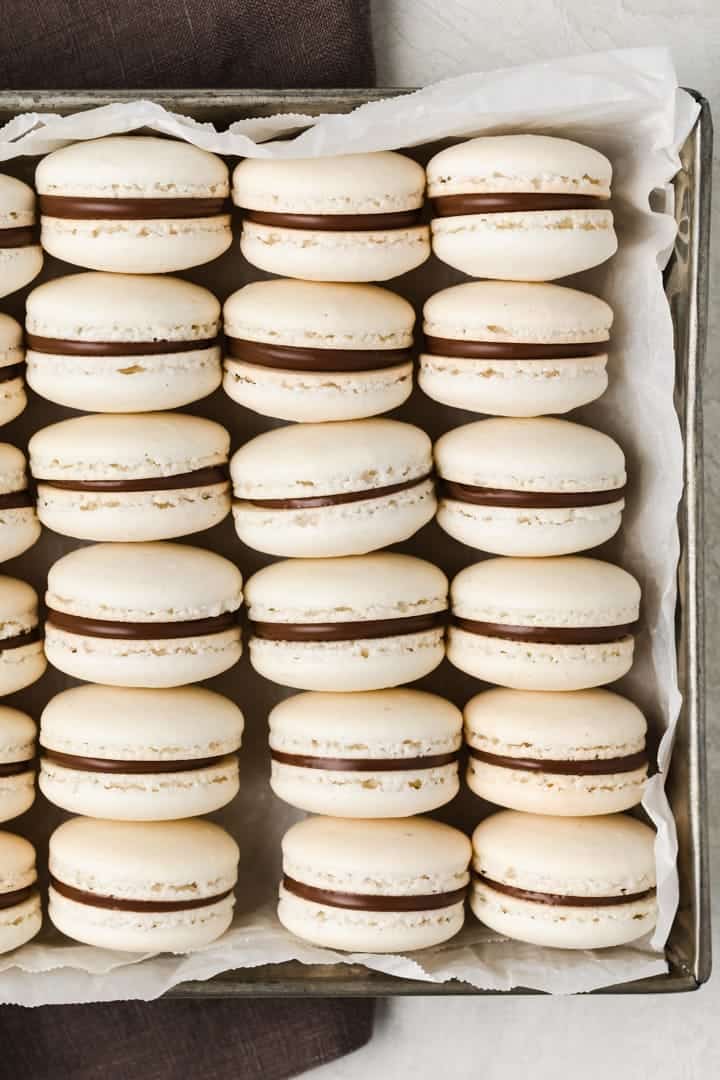
How to make French Macarons
Fold the dry ingredients into the wet ingredients. Transfer the batter to a piping bag fitted with a ½-inch tip and pipe 1-inch circles onto a cookie sheet lined with a silicone mat. Let the piped circles sit for 45 minutes to 1 hour.
The outer surface should feel completely dry before going into the oven. Have the oven preheating while the circles dry. It’s super important that they go into a hot oven.
The Ingredients
This basic French macaron recipe uses very standard ingredients. You may already have them on hand.
- Almond flour: Make sure to use almond flour*! It’s finely ground and I’ve had the best success with this over almond meal.
- Powdered sugar: It’s the same as confectioners’ sugar and is the main sweetener in macarons.
- White sugar: A small mound of granulated sugar is used to make the meringue base.
- Egg whites: Room temperature egg whites are a must!
- Cream of tartar: Helps to stabilize the egg whites so they whip up to stiff peaks.
- Vanilla bean paste: It’s completely optional to use vanilla bean paste* but I love the flavor it adds.
Equipment needed
- Stand mixer: A stand mixer* is going to work best for whipping up the egg whites.
- You can use a hand-held electric mixer* but keep in mind that it may take longer for the egg whites to whip to stiff peaks.
- Silicone spatula: A silicone spatula* works best for folding the dry ingredients into the egg whites.
- Baking pans: You’ll need 4 large baking sheets*. This recipe makes a lot of macarons.
- Silicone baking mat: I love to use silicone baking mats* for macarons. It has a template printed on the mat so you don’t need to print one off.
- Piping bags: You’ll need large piping bags* for the amount of batter the recipe yields.
- Piping tip: I like smaller piping tips like this Wilton 2A*. It pipes perfect mounds of batter for well-shaped macarons.
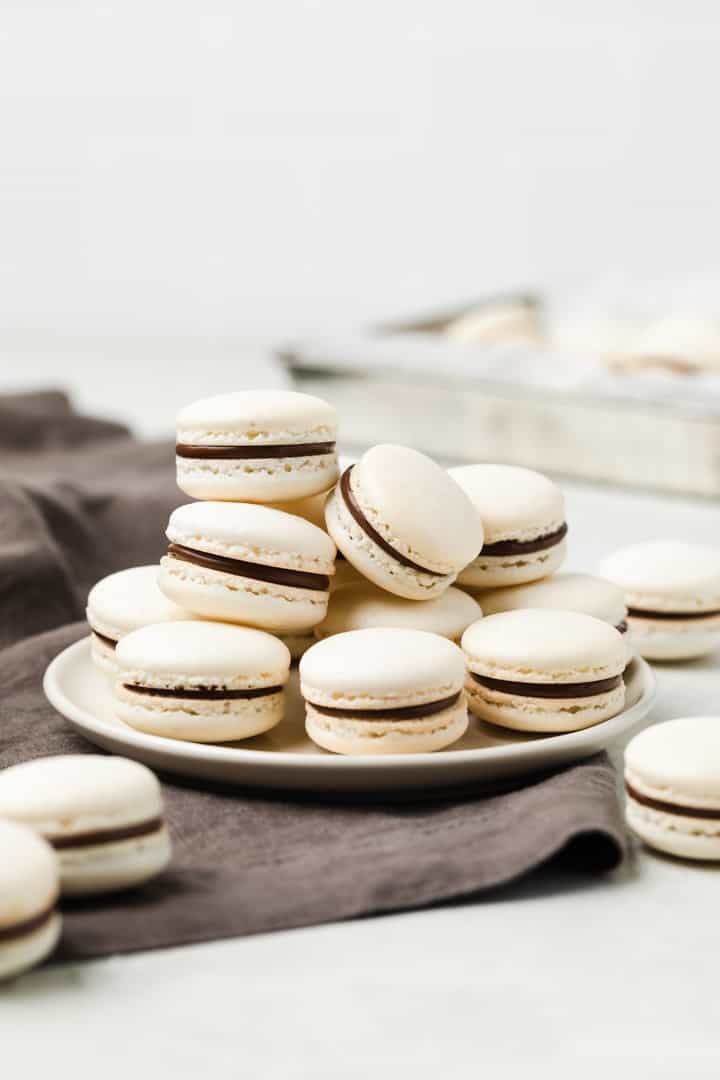
The Instructions
Step 1: Preheat the oven and prepare your workstation
Set the oven rack to the lower third position. This is just below the center of the oven. Place an empty baking sheet on the rack and line 4 more baking sheets with silicone macaron mats.
Or you can use a 1.5-inch round cookie cutter and trace 20 circles onto sheets of parchment paper cut to fit the baking pans. Set another sheet of parchment paper over each template.
Preheat the oven to 300°F.
Fit a large piping bag with a medium round piping top and set aside.
Step 2: Combine the dry ingredients
You’ll want to sift the almond meal and powdered sugar together in a large bowl. Do this 2-3 times with a fine-mesh sieve and discard any large clumps. Don’t try to press those clumps through the sieve. Just toss them out!
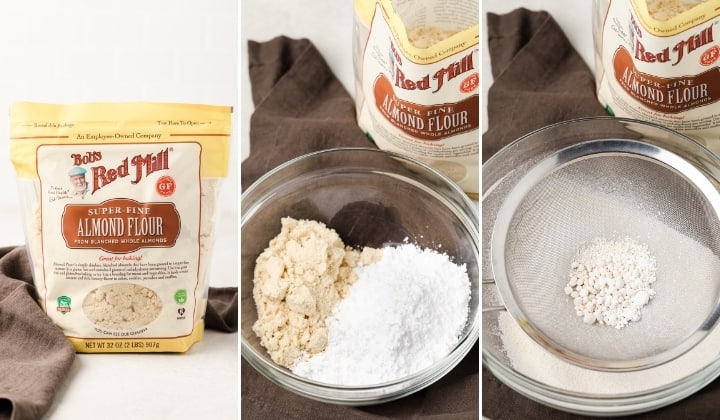
Step 3: Whip the egg whites
Add the eggs whites and cream of tartar to the bowl of a stand mixer. Using the whisk attachment, beat the egg whites on medium speed until foamy.
With the mixer running, gradually add the granulated sugar. Once all the sugar is added, turn the speed up to high and beat until the whites are the consistency of shaving cream.
At this point, you can add the vanilla and a few drops of food coloring if you wish.
Continue to beat on high speed until stiff peaks form. Take extra care here so you don’t over whip the egg whites. You don’t want them to be dry and foamy. The meringue should be thick, stiff, and glossy.
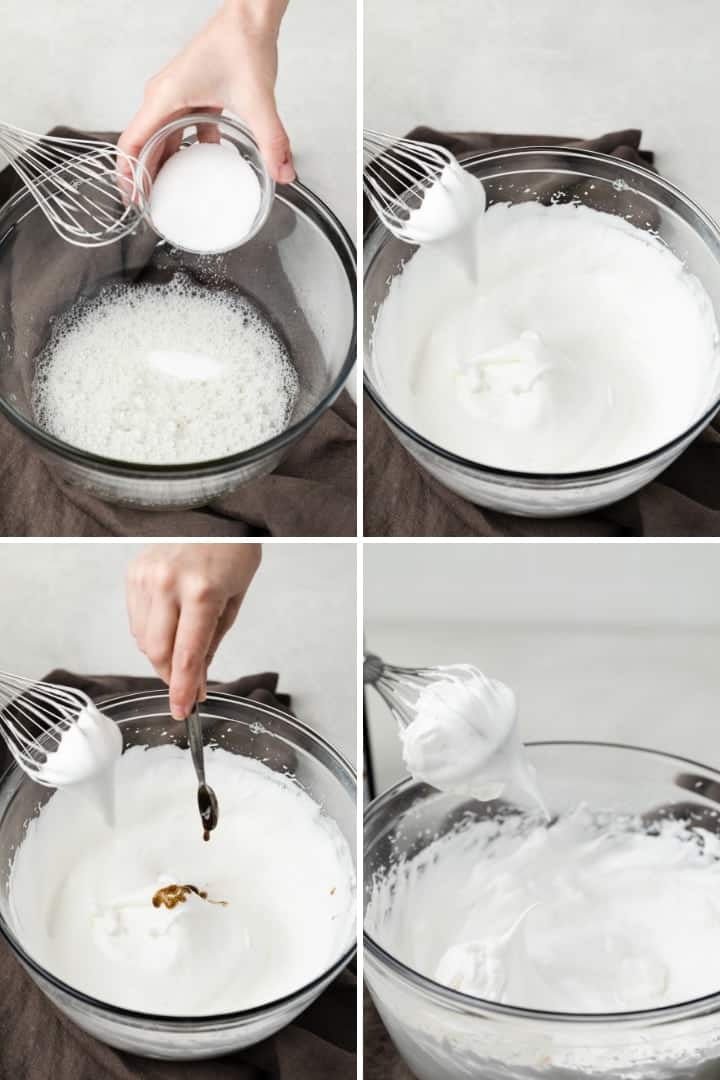
Step 4: Macaronage
Use a silicone spatula and fold half the almond mixture into the meringue. It’s okay to be a little rough at the point. You want to knock some of the air out of the batter.
Add the remaining almond mixture and gently fold everything together. This is the part where the batter can go wrong. Overmixing or undermixing will cause issues with how the macarons bake up.
After a couple of stirs, you’ll need to stop and check the consistency of the batter. Continue to do this until the batter is just right.
The batter should be shiny and flow like lava. You will be able to let the batter slide off the spatula as you draw a figure 8 and the batter won’t break.
The figure 8 you just drew should rest on top of the batter in the bowl without sinking in and losing its shape.
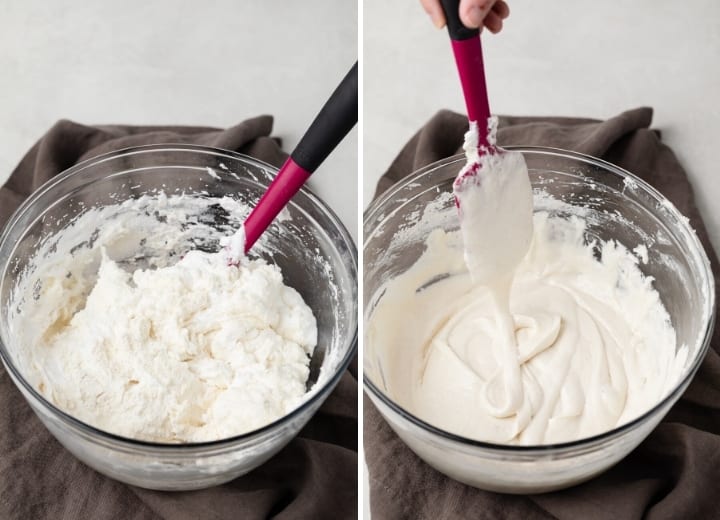
Step 5: Pipe and let dry
Fill the prepared piping bag with the macaron batter. Hold the piping bag at a 90° angle, straight up and down, and pipe small blobs of batter to fill the template.
Hold the baking sheet firmly with both hands and bang it on the countertop several 2-4 times. This will remove any air bubbles or imperfections on the surface.
Use a toothpick to touch up any bubbles or divots that are stubborn to even out. Just gently swirl the tip of the toothpick in the imperfection until the batter evens out.
If you wish to use sprinkles, add them now.
Allow the macarons to sit at room temperature until they form a skin and are no longer sticky when you gently touch them.
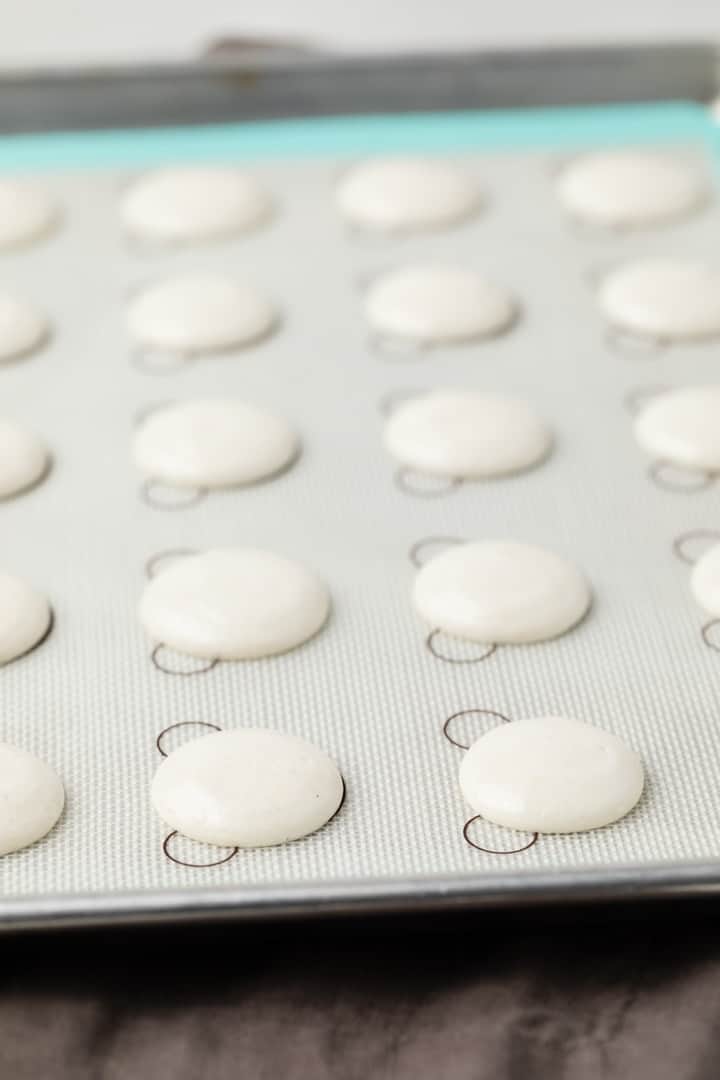
Step 6: Bake
Bake the macarons, one sheet at a time, by setting the baking sheet on top of the preheated sheet in the oven. Doubling the baking pans like this helps prevent the bottoms from turn too brown before the shells are finished baking.
Let them bake for about 15-18 minutes, until the shells have developed the signature foot /ruffle on the bottom. Take care and don’t let the macarons brown.
To check for doneness, you can gently press on the shell and lightly rock your finger back and forth. If the top of the macaron is wiggly, it needs another minute or two to bake.
Remove from the oven and allow the shells to cool for 10 minutes before removing them from the pan. Repeat with the remaining baking sheets.
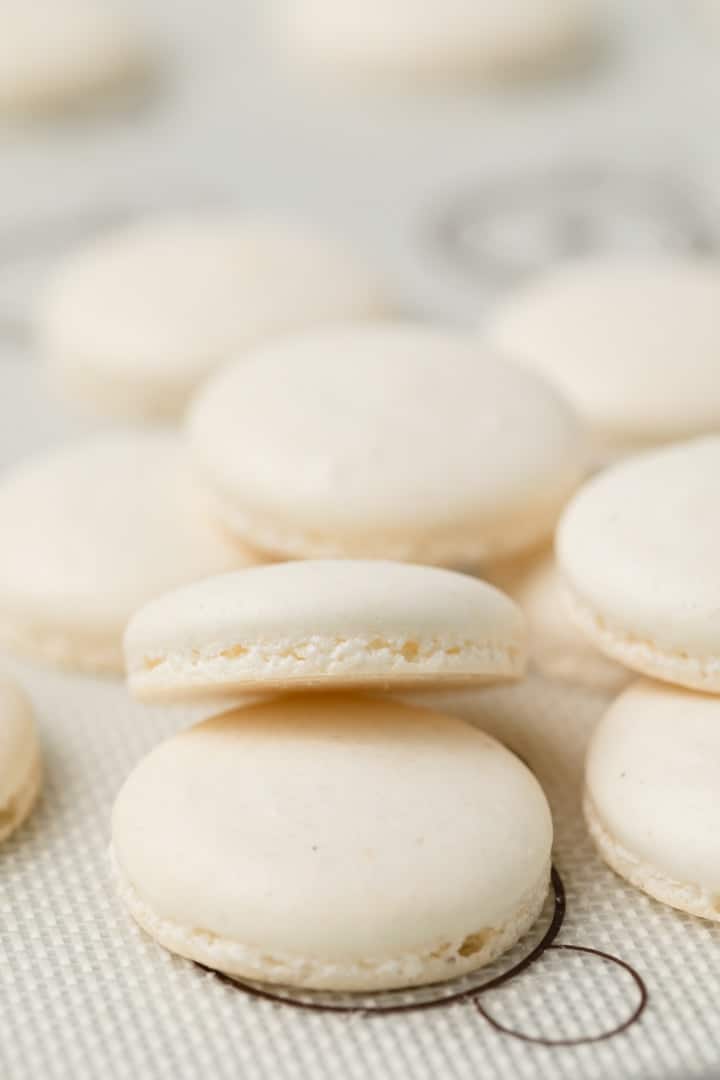
Step 7: Fill the shells
Once the shells are completely cooled, you can fill them with your desired filling. For this recipe, I used Nutella as a filling. I warmed it slightly in the microwave so it would be easier to pipe.
Take a minute to find mates for each shell, make sure they are similar in size. Then add your filling to a small piping bag fitted with a small round tip. Pipe a small amount onto the bottom side of one shell then top it with its matching shell.
Place the filled cookies in an airtight container and refrigerate them for 1-3 days. The filling will meld with the shells, creating a soft and chewy texture. It’s worth the wait!
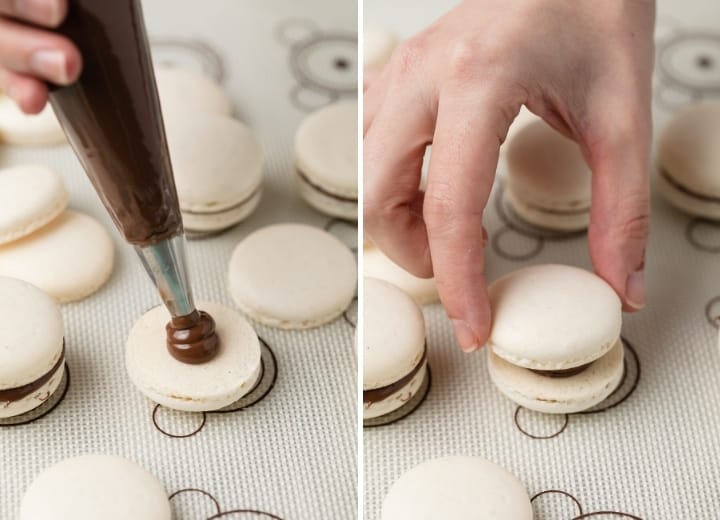
Tips for making Macarons:
- When choosing powdered sugar for macarons, be sure cornstarch is listed on the ingredient label.
- While it’s not completely necessary, you can have better success when you process the almond flour and powdered sugar in the food processor for 2 minutes before sifting.
- Separate the egg whites while they are cold then place them in a glass dish covered with a lint-free cloth or paper towel until they reach room temperature.
- Wash and thoroughly dry your mixing bowl and whisk attachment before whipping the egg whites. This extra step will ensure that both are clean of oils which can affect how well the egg whites whip up.
- Stop whipping the egg whites as soon as they reach stiff peaks. If you overwhip and end up with dry styrofoam egg whites, you’ll have to start over. Overbeaten egg whites will cause the macarons to become hollow and crack.
- Do not attempt to tint your shells until you have mastered the technique of making macarons. Adding in an extra component can throw the batter off balance and ruin the shells.
- Bake the macarons on the lower third rack in the oven. This is immediately below the center. This position prevents the tops from becoming too brown.
- Because the macarons are baked lower in the oven, it’s important to double up the baking sheet! This helps prevent the bottoms from becoming too brown.
- Let the shells cool completely before trying to remove them from the pan. If you try to remove them while they are warm, the feet will stick and possibly tear off.
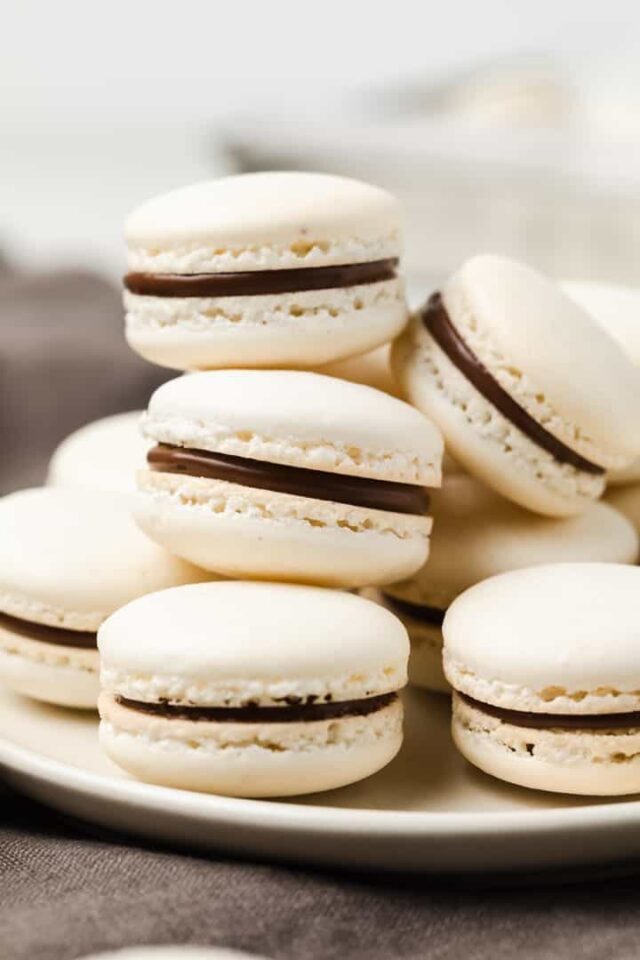
How to color macarons?
Once you have made a few successful batches, you can begin experimenting with coloring the shells. You can use gel or powdered food coloring and gently fold it into the whipped egg whites. You will want to make it darker than the color you are aiming for because the color will fade slightly during baking.
How to flavor macarons?
It is best to avoid adding flavor to the macaron shells themselves, but you can sandwich the shells around a variety of fillings. Here are a few of my favorite:
- Chocolate ganache
- Chocolate buttercream
- Peanut butter frosting
- Pineapple curd
- Lemon curd
- Raspberry frosting
- Coconut buttercream
- Caramel sauce
How to store
Refrigerate: Macaron shells can be made up to 3 days in advance. Store in an airtight container and separate the shells with layers of parchment paper. Keep refrigerated until ready to use.
Once filled, store the macarons in an airtight container in the refrigerator for up to 3 days.
Freeze: Unfilled macaron shells can be stored in an airtight container in the freezer for up to 1 month. Thaw in the refrigerator for at least 2 hours before using. After thawing, the shells will remain good for 2-4 days.
Once filled, macarons can be frozen for up to 1 month. Don’t freeze macarons filled with high moisture fillings like jellies. Thaw in the refrigerator for at least 2 hours before serving. After thawing, the macarons will remain good for 2-4 days.
French Macarons
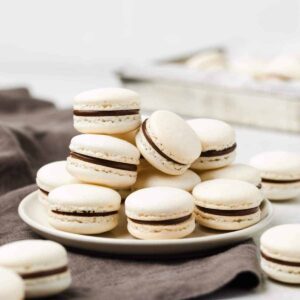
Ingredients
For the shells
- 270 grams confectioners' sugar
- 150 grams almond flour
- 150 grams egg whites, at room temperature
- ¼ teaspoon cream of tartar
- 52 grams granulated sugar
- ½ teaspoon vanilla bean paste
- gel or powdered food coloring
Instructions
- Set the oven rack to the lower third position. This is just below the center of the oven. Place an empty baking sheet on the rack and line 4 more baking sheets with silicone macaron mats. Preheat the oven to 300°F.
- Using a fine-mesh sieve, sift the almond flour and confectioners sugar into a large bowl. Repeat 2-4 times and discard any clumps. Don’t force the clumps through the sieve!
- In the bowl of a stand mixer fitted with the whisk attachment, whip the egg whites and cream of tartar on medium speed until foamy. Gradually add the granulated sugar. Turn the speed up to high and whip until soft peaks form. Add the vanilla and 1-2 drops of food coloring if desired.
- Continue to whip on high speed until a thick, glossy meringue forms. Take extra care to not over whip.
- Using a silicone spatula, fold half the almond mixture into the meringue until fully combined. It’s okay to be a little rough at the point. You want to knock some of the air out of the batter.
- Add the remaining almond mixture and gently fold everything together. This is the part where the batter can go wrong. Overmixing or undermixing will cause issues with how the macarons bake up. After a couple of stirs, you’ll need to stop and check the consistency of the batter. Continue to do this until the batter is just right. (The batter should be shiny and flow like lava. You will be able to let the batter slide off the spatula as you draw a figure 8 and the batter won’t break. The figure 8 you just drew should rest on top of the batter in the bowl without sinking in and losing its shape.)
- Transfer the batter to a large pastry bag fitted with a medium round piping tip. Be as gentle as you can with the process. Try not to overwork the batter.
- Pipe 1 to 2-inch rounds onto the prepared baking sheets. Gently tap the baking sheet on the countertop to bring any air bubbles to the surface. Let the macarons sit for 30 to 60 minutes, until a dry skin forms on the surface. They should not feel sticky to the touch when going into the oven.
- Bake one sheet at a time for about 15 to 18 minutes. The macarons are done when you can gently press on the shell and lightly rock your finger back and forth without it moving. If the top of the macaron is wiggly, it needs another minute or two to bake.
- Cool the shells completely on the baking sheet set on a wire rack. Do not attempt to remove the shells from the silicone mat until they are completely cooled or they may stick and break off.
- Sandwich two cookies together with your favorite filling. Some popular choices are chocolate ganache, chocolate buttercream, pineapple curd, lemon curd, raspberry frosting, coconut buttercream, or caramel sauce.
- Store the macarons in the refrigerator for at least 1-3 days and bring them to room temperature just before serving. They taste the best this way.
Notes
- Make sure the confectioners’ sugar contains cornstarch. This ingredient will make all the difference in how the macarons turn out.
- If you don’t have a silicone baking mat for macarons, you can use a 1.5-inch round cookie cutter and trace 20 circles onto sheets of parchment paper cut to fit the baking pans. Set another sheet of parchment paper over each template.
- Make sure you double up on the baking sheet or the bottoms of the macarons will be too brown!
- Read the full post above the recipe. There are valuable tips and imagery to help guide you in the process.
- Refrigerate: Macaron shells can be made up to 3 days in advance. Store in an airtight container and separate the shells with layers of parchment paper. Keep refrigerated until ready to use.
- Once filled, store the macarons in an airtight container in the refrigerator for up to 3 days.
- Freeze: Unfilled macaron shells can be stored in an airtight container in the freezer for up to 1 month. Thaw in the refrigerator for at least 2 hours before using. After thawing, the shells will remain good for 2-4 days.
- Once filled, macarons can be frozen for up to 1 month. Don’t freeze macarons filled with high moisture fillings like jams & jellies. Thaw in the refrigerator for at least 2 hours before serving. After thawing, the macarons will remain good for 2-4 days.
Nutrition
The nutrition information provided is for convenience and as a courtesy only. It is not guaranteed to be accurate because nutrition information can vary for a variety of reasons. For precise nutritional data use your preferred nutrition calculator and input the exact ingredients and brands you used in the recipe.

Any advice for macarons that become quite fragile once filled? The shell break easily when pressure is applied. Taste is yummy though. I mainly made ganache fillings
Thanks!
Under baked shells or over mixed batter can cause the macaron shells to be fragile. Make sure the meringue has peaks that are shooting straight up. To know when the macarons are done baking, wiggle one shell and if it jiggles continue to bake it.
What’s the recipe in cups?
Hi Michelle! Because macarons can be so finicky, I only suggest using weight measurements. This is why cups are not provided.
I made this recipe last night with such success! My sister-in-law is gluten and dairy free. I made Jen’s pistachio butter, added coconut oil, then powdered sugar. YUM! Thank you for your great tutorials!
So happy to hear you love the recipe, Paula!
I have tried many many recipes on French Macarons. There are so a lot of hit and miss. This recipe is by far the most accurate one. I have made four batches, except the first one, by my mistake, had a little nipple on top, all came out perfect!!!! Thank you soooooooooooooooo much for the perfect recipe!
I’m so glad you had success with the macarons!